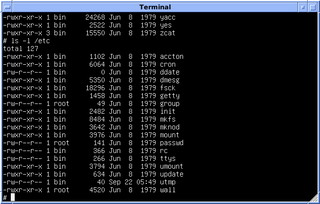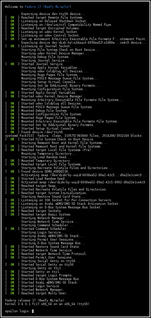This article needs additional citations for verification .(February 2016) (Learn how and when to remove this template message) |
An orphan process is a computer process whose parent process has finished or terminated, though it remains running itself.
This article needs additional citations for verification .(February 2016) (Learn how and when to remove this template message) |
An orphan process is a computer process whose parent process has finished or terminated, though it remains running itself.
In a Unix-like operating system any orphaned process will be immediately adopted by the special init system process: the kernel sets the parent to init. This operation is called re-parenting and occurs automatically. Even though technically the process has the "init" process as its parent, it is still called an orphan process since the process that originally created it no longer exists. In other systems orphaned processes are immediately terminated by the kernel. In modern Linux systems, an orphan process may be reparented to a "subreaper" process instead of init. [1] [2]
A process can be orphaned unintentionally, such as when the parent process terminates or crashes. The process group mechanism in most Unix-like operating systems can be used to help protect against accidental orphaning, where in coordination with the user's shell will try to terminate all the child processes with the "hangup" signal (SIGHUP), rather than letting them continue to run as orphans. More precisely, as part of job control, when the shell exits, because it is the "session leader" (its session id equals its process id), the corresponding login session ends, and the shell sends SIGHUP to all its jobs (internal representation of process groups).
It is sometimes desirable to intentionally orphan a process, usually to allow a long-running job to complete without further user attention, or to start an indefinitely running service or agent; such processes (without an associated session) are known as daemons, particularly if they are indefinitely running. A low-level approach is to fork twice, running the desired process in the grandchild, and immediately terminating the child. The grandchild process is now orphaned, and is not adopted by its grandparent, but rather by init. Higher-level alternatives circumvent the shell's hangup handling, either telling the child process to ignore SIGHUP (by using nohup), or removing the job from the job table or telling the shell to not send SIGHUP on session end (by using disown in either case). In any event, the session id (process id of the session leader, the shell) does not change, and the process id of the session that has ended is still in use until all orphaned processes either terminate or change session id (by starting a new session via setsid(2)).
To simplify system administration, it is often desirable to use a service wrapper so that processes not designed to be used as services respond correctly to system signals. An alternative to keep processes running without orphaning them is to use a terminal multiplexer and run the processes in a detached session (or a session that becomes detached), so the session is not terminated and the process is not orphaned.
A server process is also said to be orphaned when the client that initiated the request unexpectedly crashes after making the request while leaving the server process running.
These orphaned processes waste server resources and can potentially leave a server starved for resources. However, there are several solutions to the orphan process problem:

GNU Hurd is the multiserver microkernel written as part of GNU. It has been under development since 1990 by the GNU Project of the Free Software Foundation, designed as a replacement for the Unix kernel, and released as free software under the GNU General Public License. When the Linux kernel proved to be a viable solution, development of GNU Hurd slowed, at times having slipped intermittently between stasis and renewed activity and interest.
On Unix and Unix-like computer operating systems, a zombie process or defunct process is a process that has completed execution but still has an entry in the process table: it is a process in the "Terminated state". This occurs for the child processes, where the entry is still needed to allow the parent process to read its child's exit status: once the exit status is read via the wait system call, the zombie's entry is removed from the process table and it is said to be "reaped". A child process always first becomes a zombie before being removed from the resource table. In most cases, under normal system operation zombies are immediately waited on by their parent and then reaped by the system – processes that stay zombies for a long time are generally an error and cause a resource leak, but the only resource they occupy is the process table entry – process ID.

A kernel panic is a safety measure taken by an operating system's kernel upon detecting an internal fatal error in which either it is unable to safely recover or continuing to run the system would have a higher risk of major data loss. The term is largely specific to Unix and Unix-like systems. For Microsoft Windows operating systems the equivalent term is "Stop error", resulting in a bug check screen that presents the bug check code on a blue background in early versions of Windows, or on a green background on the Xbox One platform as well as in Windows 10 preview builds.
A background process is a computer process that runs behind the scenes and without user intervention. Typical tasks for these processes include logging, system monitoring, scheduling, and user notification. The background process usually is a child process created by a control process for processing a computing task. After creation, the child process will run on its own, performing the task independent of the control process, freeing the control process of performing that task.
A child process in computing is a process created by another process. This technique pertains to multitasking operating systems, and is sometimes called a subprocess or traditionally a subtask.
In computing, a parent process is a process that has created one or more child processes.
In computing, the process identifier is a number used by most operating system kernels—such as those of Unix, macOS and Windows—to uniquely identify an active process. This number may be used as a parameter in various function calls, allowing processes to be manipulated, such as adjusting the process's priority or killing it altogether.

In multitasking computer operating systems, a daemon is a computer program that runs as a background process, rather than being under the direct control of an interactive user. Traditionally, the process names of a daemon end with the letter d, for clarification that the process is in fact a daemon, and for differentiation between a daemon and a normal computer program. For example, syslogd is a daemon that implements system logging facility, and sshd is a daemon that serves incoming SSH connections.

GNU Screen is a terminal multiplexer, a software application that can be used to multiplex several virtual consoles, allowing a user to access multiple separate login sessions inside a single terminal window, or detach and reattach sessions from a terminal. It is useful for dealing with multiple programs from a command line interface, and for separating programs from the session of the Unix shell that started the program, particularly so a remote process continues running even when the user is disconnected.
Signals are a limited form of inter-process communication (IPC), typically used in Unix, Unix-like, and other POSIX-compliant operating systems. A signal is an asynchronous notification sent to a process or to a specific thread within the same process to notify it of an event. Signals originated in 1970s Bell Labs Unix and were later specified in the POSIX standard.
In computing, kill is a command that is used in several popular operating systems to send signals to running processes.
nohup is a POSIX command to ignore the HUP (hangup) signal. The HUP signal is, by convention, the way a terminal warns dependent processes of logout.
On POSIX-compliant platforms, SIGHUP is a signal sent to a process when its controlling terminal is closed. SIGHUP is a symbolic constant defined in the header file signal.h.

In Unix-based computer operating systems, init is the first process started during booting of the computer system. Init is a daemon process that continues running until the system is shut down. It is the direct or indirect ancestor of all other processes and automatically adopts all orphaned processes. Init is started by the kernel during the booting process; a kernel panic will occur if the kernel is unable to start it. Init is typically assigned process identifier 1.

NetworkManager is a daemon that sits on top of libudev and other Linux kernel interfaces and provides a high-level interface for the configuration of the network interfaces.
In Unix and Unix-like operating systems, job control refers to control of jobs by a shell, especially interactively, where a "job" is a shell's representation for a process group. Basic job control features are the suspending, resuming, or terminating of all processes in the job/process group; more advanced features can be performed by sending signals to the job. Job control is of particular interest in Unix due to its multiprocessing, and should be distinguished from job control generally, which is frequently applied to sequential execution.
In a POSIX-conformant operating system, a process group denotes a collection of one or more processes. Among other things, a process group is used to control the distribution of a signal; when a signal is directed to a process group, the signal is delivered to each process that is a member of the group.
Linux startup process is the multi-stage initialization process performed during booting a Linux installation. It is in many ways similar to the BSD and other Unix-style boot processes, from which it derives.
runit is an init scheme for Unix-like operating systems that initializes, supervises, and ends processes throughout the operating system. Runit is a reimplementation of the daemontools process supervision toolkit that runs on many Linux-based operating systems, as well as the macOS, *BSD, and Solaris operating systems. Runit features parallelization of the start up of system services, which can speed up the boot time of the operating system.

systemd is a software suite that provides an array of system components for Linux operating systems.
From Linux 3.4 onwards processes can issue the prctl() system call with the PR_SET_CHILD_SUBREAPER option, and as a result they, not process #1, will become the parent of any of their orphaned descendant processes.
Definition : An orphan process is running process whose parent process is terminated or finished.